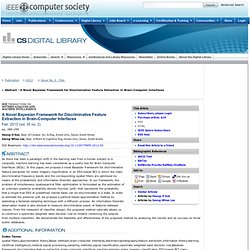

Quadcopter control in three-dimensional space using a noninvasive motor imagery-based brain–computer interface - Abstract - Journal of Neural Engineering. Building a 15-foot-tall brain-controlled brain for Burning Man and beyond. My cousin Katherine Leipper is part of a crew that's building a 15-foot-tall head and brain with interactive light and flame effects that will be controlled by a participant's brain waves.

Yup. Weirdness runs in our family. She and her co-makers will take it to Burning Man, but the bigger plan is to take it around to schools after the festival, "to get kids excited about science, technology and fabrication. " Stytsenko. - Introduction - Acquiring an EEG system can be a costly issue, thus it would be a great advantage having a fairly cheap EEG device that delivers data of similar quality.

The topic of this project was the evaluation of the Emotiv EPOC [1] consumer EEG device and the further investigation about possible scientific research application by the means of measuring reliability and validity of the acquired EEG data compared to a conventional EEG system. Emotiv EPOC is a consumer BCI based on EEG technology and priced at 750$, making it much more affordable compared to ordinary EEG systems which could easily cost a multiple. It offers 14 electrodes mounted on a wireless headset, which is effortlessly set up and connected to a computer. Initially it was introduced for PC gaming, but the research edition enables access to raw data for further analysis. A P300-based Quantitative Comparison between the Emotiv Epoc Headset and a Medical EEG Device.
Browse Journals Browse Proceedings A P300-based Quantitative Comparison between the Emotiv Epoc Headset and a Medical EEG Device Matthieu Duvinage, Thierry Castermans, Thierry Dutoit, Mathieu Petieau, Thomas Hoellinger, Caty De Saedeleer, Karthik Seetharaman, and Guy Cheron Keywords.

Akalin_Acar_ForwardModelErrors13. Software interface for controlling diverse robotic platforms using BMI. Subasi. TBME-00357-2008-R2-preprint_%5b0%5d. Surfing the internet with a BCI mouse. Summary of "Surfing the internet with a BCI mouse.

" In this paper, we present a new web browser based on a two-dimensional (2D) brain-computer interface (BCI) mouse, where our major concern is the selection of an intended target in a multi-target web page. A real-world web page may contain tens or even hundreds of targets, including hyperlinks, input elements, buttons, etc. In this case, a target filter designed in our system can be used to exclude most of those targets of no interest.
Specifically, the user filters the targets of no interest out by inputting keywords with a P300-based speller, while keeps those containing the keywords. Such filtering largely facilitates the target selection task based on our BCI mouse. Affiliation School of Automation Science and Engineering, South China University of Technology, Guangzhou 510640, People's Republic of China. Journal Details This article was published in the following journal. Adaptive BCI based on variational Bayesian Kalman filtering: an empirical evaluation. This paper proposes the use of variational Kalman filtering as an inference technique for adaptive classification in a brain computer interface (BCI).

The proposed algorithm translates electroencephalogram segments adaptively into probabilities of cognitive states. It, thus, allows for nonstationarities in the joint process over cognitive state and generated EEG which may occur during a consecutive number of trials. Nonstationarities may have technical reasons (e.g., changes in impedance between scalp and electrodes) or be caused by learning effects in subjects. We compare the performance of the proposed method against an equivalent static classifier by estimating the generalization accuracy and the bit rate of the BCI.
Using data from two studies with healthy subjects, we conclude that adaptive classification significantly improves BCI performance. The stochastic approximation method for adaptive Bayesian classifiers: towards online brain–computer interfaces. Parallel Processing of Massive EEG Data with MapReduce. Automatic removal of ocular artif. A Survey of Signal Processing Algorithms in BCI Based on Electrical Brain Signals.
A Novel Bayesian Framework for Discriminative Feature Extraction in Brain-Computer Interfaces. Index Terms: Citation: Heung-Il Suk, Seong-Whan Lee, "A Novel Bayesian Framework for Discriminative Feature Extraction in Brain-Computer Interfaces," IEEE Transactions on Pattern Analysis and Machine Intelligence, vol. 35, no. 2, pp. 286-299, Feb. 2013, doi:10.1109/TPAMI.2012.69.

EEG Motor Movement/Imagery Dataset. This dataset was created and contributed to PhysioNet by the developers of the BCI2000 instrumentation system, which they used in making these recordings.

The system is described in: Schalk, G., McFarland, D.J., Hinterberger, T., Birbaumer, N., Wolpaw, J.R. BCI2000: A General-Purpose Brain-Computer Interface (BCI) System.IEEE Transactions on Biomedical Engineering 51(6):1034-1043, 2004. [In 2008, this paper received the Best Paper Award from IEEE TBME.] Please cite this publication and www.bci2000.org when referencing this material, and also include the standard citation for PhysioNet: Multi-Class Motor Imagery EEG Decoding for Brain-Computer Interfaces. Projectbci. Free EEG data database freely ERP data publicly available. EEG in Dementia and Encephalopathy. Alzheimer disease Electroencephalography (EEG) is the only clinical diagnostic instrument that directly reflects cortical neuronal functioning.

Although the EEG may be normal or minimally disturbed in a number of patients in the initial stages of Alzheimer disease (AD), an abnormal EEG usually is recorded later in the course. A large percentage of patients with moderately severe to severe AD exhibit abnormal EEGs. Thus, patients with AD may have an impairment of interhemispheric functional connectivity in both nonstimulus and stimulus conditions, which suggests a failure of normal stimulation-related brain activation in AD. The alpha coherence decrease could be related to alterations in corticocortical connectionsThe delta coherence increase suggests lack of influence of subcortical cholinergic structures on cortical electrical activity Epileptiform activity may occur more frequently in patients with AD than in the general population; clinical tonic-clonic seizures can occur.
Pick disease. Biofeedback,Neurofeedback,EEG,QEEG,NeuroGuide. Brain-Computer Interface Technologies in the Coming Decades. So dynamic and complex that technological capabilities are overwhelming human capabilities to optimally interact with and leverage those technologies.

Fortunately, these technological advancements have also driven an explosion of neuroscience research over the past several decades, presenting engineers with a remarkable opportunity to design and develop flexible and adaptive brain-based neurotechnologies that integrate with and capitalize on human capabilities and limitations to improve human-system interactions. Emotiv Epoc - Emotiv EPOC - EEG alapú agy számítógép interfész beszámoló.pdf.